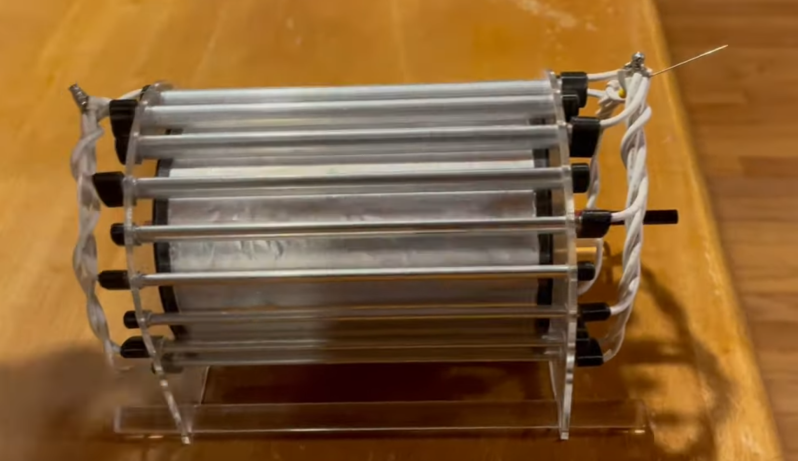While it almost seems like an insane fever dream from an otherwise brilliant inventor, Nikola Tesla’s plan to harvest energy straight out of the atmosphere and essentially give it away is more reality than fiction. It’s usually prohibitively difficult get that energy out of the atmosphere for several obvious reasons, although it is still possible to do as [lasersaber] shows with his most recent atmospheric motor.
To help solve some of the logistical problems of harvesting electricity from the atmosphere, [lasersaber] is using a Van de Graaff generator as a stand-in for the high voltage gradient that can be found when suspending a long wire in the air. He has been experimenting with high-voltage motors like this for a while now and has refined his designs for corona discharge motors like these to be big enough and have enough torque to drive a drill bit. The motors have a conductive rotor with a series of discharge tubes on the stator, and exposing a metal point on the wiring (where the atmospheric wire would attach) to a sufficiently high voltage will cause rotation. In this case, it’s around 30,000 volts but with an extremely low current.
There are a number of videos documenting his latest build, including this follow-up video where he drills an arbitrarily large number of holes in various materials to demonstrate its effectiveness. Even though he is using a Van de Graaff generator in these builds, he does also show them working with a wire suspended by a drone as well for proof-of-concept. He’s also become somewhat of an expert on high-efficiency and low-power motors and has a number of other interesting builds based on these concepts.















love this electrostatic motor: https://www.youtube.com/watch?v=s3yO7jYaD98
If you’re flying a kite in a storm to get your high voltage you can probably do away with the motor and drill bit and just do EDM directly?
XD
If you’re outstanding in your field, you might get struck by lightening…
Odd, I find myself darkening while out standing in fields.
I have a buddy that got challenged by a start up whose plan is generating electricity from cables going into the high atmosphere. Seems interesting.
Challenged = hired?
challenged, not accepted. He is the brainy PHD type, planetary scientist. Had several startups going after him as chief scientist. He told me about the project seemed interesting.
As there are many more RF transmitters in the world than when Nikola did his experiment, does that mean there is more electrical energy to harvest from the atmosphere?
According to what I read and been told yes. Hard part of course is collection.
These devices harvest static electric potential in the atmosphere, not electromagnetic radiation like radio waves
Of course, Tesla was all about AC transmission, but that doesn’t make this work any less AWESOME.
I read a story (in a Whole Earth Review) about a SF Exploratorium employee who demonstrated a dipole antenna illuminating an LED. Those in authority suggested the effect would be too unreliable to use in an exhibit. I think he was FM band centered.
Similar to this?
https://youtu.be/wUpOlqbHcjI
No magic involved, just needs a beefy broadcast transmitter nearby. Decades ago when big AM transmitters with >100kW EIRP were still a thing, some people living near such transmitters used small incandescent bulbs and an untuned antenna to light their garden shed.
Atlas Shrugged?
“an insane fever dream from an otherwise brilliant inventor, Nikola Tesla’s plan to harvest energy straight out of the atmosphereWell as he never did get a chance to build it how do we know it wouldn’t work, many other of his ideas at the time seemed fantastic and worked, maybe this one would have too? Oh, and I hear you saying “That’s as stupid as perpetual motion!” Well maybe, but if someone built an actual working perpetual motion machine I would not dismiss it out of hand.
“Well maybe, but if someone built an actual working perpetual motion machine I would not dismiss it out of hand.”
Well, I would…
Depends on what you call perpetual motion. Considering the Earth is a giant magnet that is being constantly bombarded by charged particles from the sun, you could theoretically build a motor as perpetual as the Earth and the stars. That’s all that powers the auroras. Making it practical would be the hard part.
I remember an article in Radio TV Experimenter (?) magazine back in the 70’s (?) about building electrostatic motors that is very much like this. Nice to see this coming around again.
Cost cost cost cost cost versus gain
I can’t quite figure out the rotor.
In most electrostatic motors that I’ve seen, they are made of strips, so that alternating blades charge the whole thing up pos/neg, attracting each pole to the next blade.
Here, it’s a solid sheet of aluminum foil. I’m kinda surprised that the charges stay put. Or is that what’s going on?
The image shows 2 capacitors. The stationary outer capacitor with charge separation.
Power is a function of voltage and current in DC machines. The concept is sound but impractical for producing real work on a cost per watt basis.